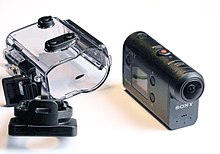Videography
It has been suggested that videographer be merged into this article. (Discuss) Proposed since June 2018. |

A videographer
Videography refers to the process of capturing moving images on electronic media (e.g., videotape, direct to disk recording, or solid state storage) and even streaming media. The term includes methods of video production and post-production. It could be considered the video equivalent of cinematography (moving images recorded on film stock). The advent of digital video recording in the late 20th century blurred the distinction between videography and cinematography, as in both methods the intermittent mechanism became the same. Nowadays, any video work outside commercial motion picture production could be called videography.
Contents
1 Uses
2 Videography in social science
3 See also
4 References
5 Further reading
Uses

An Action-cam with underwater housing.
The arrival of computers and the Internet in the 1980s created a global environment where videography covered many more fields than just shooting video with a camera, including digital animation (such as Flash), gaming, web streaming, video blogging, still slideshows, remote sensing, spatial imaging, medical imaging, security camera imaging, and in general the production of most bitmap and vector based assets. As the field progresses, videographers may produce their assets entirely on a computer without ever involving an imaging device, using software-driven solutions. Moreover, the very concept of sociability and privacy are being reformed by the proliferation of cell-phone, surveillance video, or Action-cameras, which are spreading at an exceptional rate globally.
A videographer may be the actual camera operator or they may be the person in charge of the visual design of a production (the latter being the equivalent of a cinematographer).
Videography in social science
In social sciences, videography also refers to a specific research method of video analysis, that combines ethnography with the recording of sequences of interaction that are analysed in details with methods developed on the basis of conversation analysis. One of the best known application is in workplace studies.
See also
- Event videography
- Institute of Videography
- Underwater videography
- Video production
- Wedding videography
References
Further reading
- Knoblauch H, Tuma R (2011) Videography: an interpretive approach to video-recorded micro-social interaction. In: Margolis E., Pauwels L. (eds) The Sage Handbook of Visual Methods. Thousand Oaks, CA: Sage, 414–430.